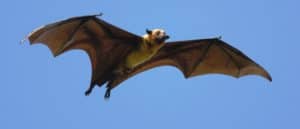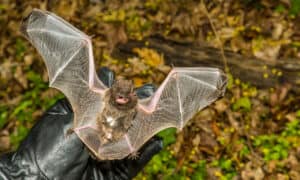Bats aren’t just scary creatures that come out on Halloween. They are fascinating flying mammals found all over the world that have a year-round job of consuming tons of insects. This makes them a vital part of the food chain. In fact, they’re so useful, some people put up bat houses to attract them. In this article, we’ll learn more about these interesting creatures. We’ll cover where bats go in winter, why you shouldn’t disturb them, and how you can attract them as a form of natural insect control.

Bats are flying mammals found all over the world. But where do bats go in winter?
©Bernd Wolter/Shutterstock.com
Description of Bats
Bats are the only mammals capable of sustained flight. They are found all over the world. except for in the Arctic and Antarctica. They come in a wide variety of sizes, from the tiny bumblebee bat, which weighs less than a penny, to the giant golden-crowned flying fox, which can have a wingspan of up to 5 feet! Depending on the species, bats can weigh anywhere from 0.07 ounces to 3.3. pounds.
Bats have furry bodies for warmth and camouflage, strong jaw muscles and teeth, and short tails. But of course, their most distinctive feature is their wings. These are made of a thin layer of skin stretched over elongated arm and finger bones. Their elbow and shoulder joints are flexible, which helps them fly with great agility. They reach speeds of 25 mph, and some species can even reach close to 100 mph! Bat flight is highly maneuverable. They can make sudden sharp changes in direction while flying in pursuit of an insect meal or evading predators like owls or eagles. About 70% of bats navigate using a form of echolocation. They make squeaks and listen for the reverberation of the sound to sense what is around them. Other animals, such as whales and porpoises, also have this ability.
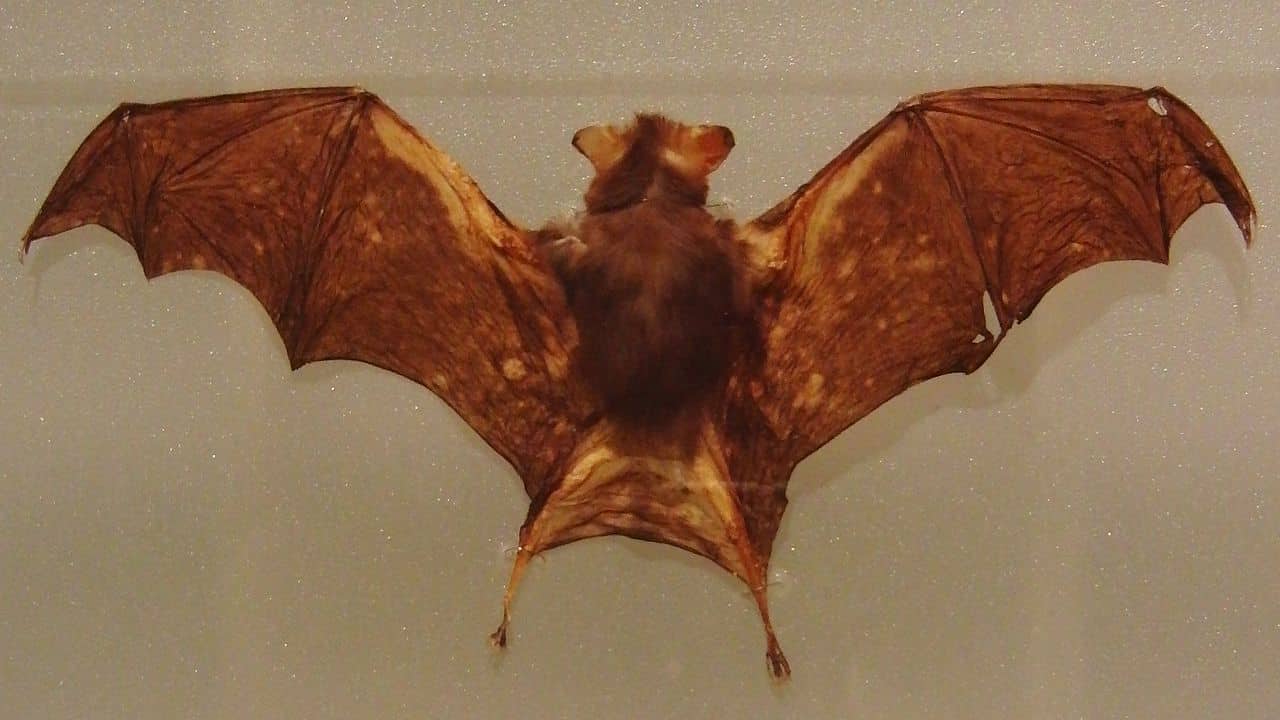
Bumblebee bats weigh less than a penny. Adorable!
©Momotarou2012 / CC BY-SA 3.0, Wikimedia Commons – License
Role of Bats in the Ecosystem
Bats play vital roles in many ecosystems. Like bees, bats transport pollen. This happens when it gets stuck in their fur as they feed on nectar or fruit, helping to fertilize plants. And those that eat fruit help distribute seeds. They drop large seeds as they eat and expel small seeds in their feces. Many plants rely on bats as essential elements of their reproductive process.
Bats that eat insects are especially important because they eat a LOT of insects. In fact, just one Myotis lucifugus (little brown bat) can consume 1,000 mosquitos an hour! A nursing mother bat consumes 4,500 insects every night! Bats consume many different species of harmful insects that spread disease and damage crops.
Finally, bats contribute to the ecosystem as prey animals themselves. Owls, eagles, and snakes are among the predators that feed on bats. If bats were removed from the environment, it would create a ripple effect throughout the food chain, endangering other species.
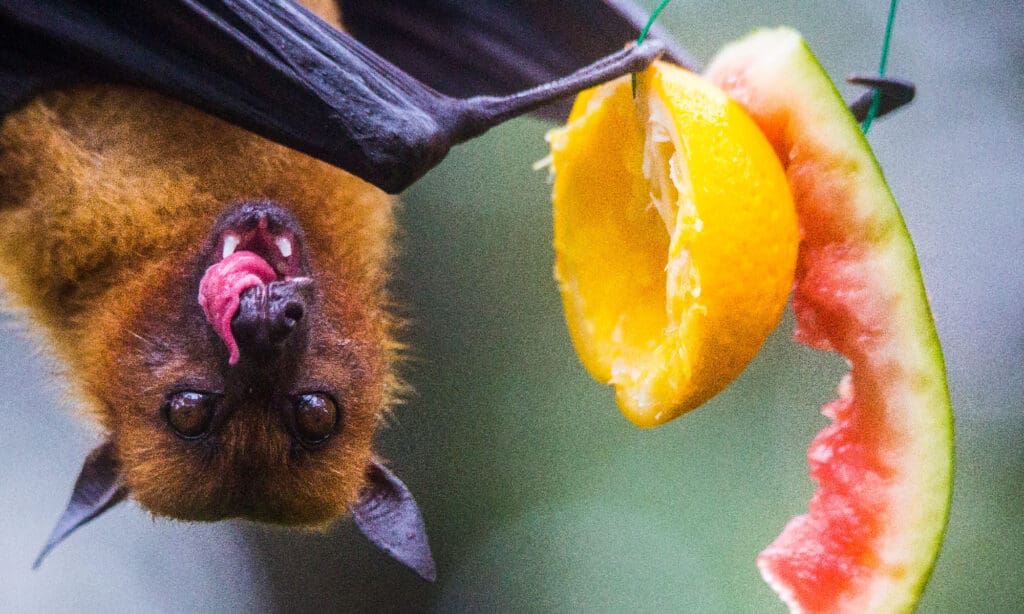
Fruit bats help pollinate different species of fruit and disburse seeds.
©Natalia Golovina/Shutterstock.com
Habitat of Bats
Bats live in many different biomes around the world, including tropical rainforests, deserts, alpine mountains, and lowland forests. Depending on the species and what is available in their environment, bats can roost in tree hollows or under loose bark, in caves or mines, or in rock crevices. Some species also adapt well to human environments, getting through holes as small as a quarter into attics of buildings or roosting in barns, sheds, or even under the shutters of a house. In choosing a habitat, bats are particularly attracted to places with stable temperatures and high humidity, which helps them survive cold weather.

Some species of bats favor caves for their habitat but others live in tree hollows, under bark, or in attics, barns, or other human spaces.
©William Cushman/Shutterstock.com
Behavior of Bats
Bats are nocturnal and many of their adaptations help them thrive in a low-light environment. Seventy percent of bats use echolocation to help them avoid obstacles and catch their prey in the dark. This involves making high-pitched noises that are beyond the range the human ear can hear and listening for the echo as the sound waves bounce back from objects around them. This sense is so precise, that bats can sense the location, shape, and distance of objects and living things. While many bats feed on insects and small animals, others drink blood from cows and other livestock while they are sleeping, usually without them noticing. Some species eat fruit, nectar, and pollen. Insect-feeding bats sometimes swarm in large numbers in the evening when their quarry is most active.
Bats are social creatures that usually live in colonies. They mate for life and are strongly territorial, aggressively defending their roosting places and mates. Their young are called pups. Most species give birth to only one pup at a time, but some species, such as the eastern red bat, frequently have twins. When roosting, bats often like to hang upside down, gripping the rough surface of a cave wall or ceiling or the rough boards of an attic or barn with their feet.
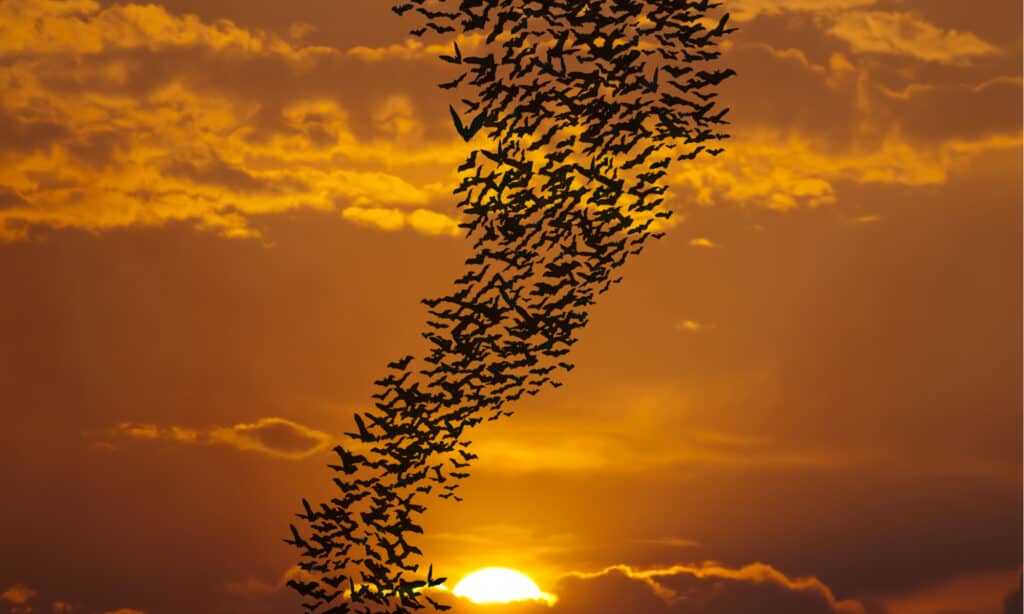
In the evenings, large numbers of bats swarm to catch insects when they are most active.
©Sarun T/Shutterstock.com
Where do Bats go in the Winter?
Okay, we’ve kept you in suspense long enough. Where do bats go in winter? As warm-blooded mammals with lightweight bodies, bats do not tolerate cold weather very well. Their response to winter depends on their species and the environment where they live:
- In warm climates, like Florida, bats stay active all year round, just like people!
- Many species in cold and temperate climates in the northern hemisphere migrate to warmer areas during the winter. As food becomes scarce and temperatures drop, bats migrate as far south as necessary to get to favorable conditions. Some species in the United States go as far as Mexico and Central America for the winter.
- Other species go into a kind of hibernation called torpor during the winter. In torpor, their body temperature and metabolism drop, allowing them to survive on stored fat reserves when food supplies are scarce. They spend long hours resting motionless, clustered together for warmth in their winter roosts. Bats prefer to spend the winter in caves, mines, tunnels, or heated buildings where the temperature and humidity will remain stable throughout the winter. Other types of bats roost in trees, including clefts of branches, under tree bark, and in hollows.

In the winter, many species of bat hibernate, huddled together for warmth and remaining as motionless as possible to conserve energy.
©iStock.com/Remus86
Why You Shouldn’t Disturb Bats
Bats are fascinating creatures but they have a troubled history with people. As mysterious “creatures of the night,” they have acquired a cultural reputation for being connected with evil. It can be understandably disturbing to enter a dark room or cave and have a flapping creature go past your head. Not understanding the beauty and value of these animals, some people take it upon themselves to try to kill them. Other people seeking thrills or genuinely appreciating these animals seek them out, sometimes just to photograph them, but other times wanting to handle them or just stir them up to see them fly. All of these are terrible ideas, and here are just a few reasons why:
- Bats are an important part of the ecosystem: Bats play a vital role in controlling insect populations and pollinating plants. Disturbing bats can disrupt their ability to perform these important ecological functions.
- Bats are at risk: Many bat species are facing population declines due to human activities such as habitat destruction, pesticide use, and disease. Disturbing bats can further stress already vulnerable populations.
- Bats may carry diseases: Some bat species can carry diseases such as rabies and various viruses, which can be transmitted to humans if they are bitten or scratched. Disturbing bats increases the risk of contact with these diseases.
- Bats are protected by laws: Many bat species are protected by laws such as the Endangered Species Act and state wildlife laws. Disturbing bats is illegal and can result in fines and penalties.
- It’s important to avoid disturbing bats during critical times such as roosting, mating, and raising young. Bothering them at these times can cause mothers to abandon their young, leading to their death, or can cause them to use up valuable energy reserves that are needed for survival.
It’s important to respect and protect bats, avoid disturbing them, and follow guidelines, regulations, and laws when observing them.

Bats can spread a number of diseases to people and pets – a good reason not to disturb them in winter or any time of year.
©Fit Ztudio/Shutterstock.com
How to Attract Bats to Your Yard
OK, if you’re convinced that bats are wonderful little animals that perform a useful function and you would like to have some on your property, though maybe not in your house, here are some things you can do to make them feel welcome:
- Learn what kinds of bats live in your areas and what kinds of habitat they require. Bat Conservation International is a great resource for you.
- Water the bats. Bats are thirsty little dudes. They can lose half their body weight in water a day. If you don’t have a natural water source already on your property, a birdbath, fountain, or even a swimming pool will make your property more appealing to them. And probably to you, too.
- Attract insects. If you plant fragrant, nocturnal-blooming flowers, you’ll attract more nocturnal insects, which will attract nocturnal bats.
- Buy or build them a house, which you can attach to a tree or an exterior wall of your house. You’ll need to do a little research to decide which side of the house and how high up to affix it, as the temperature and humidity must be right.
- Spray bat attractant in their new home. Just as you can purchase bat repellant sprays, you can buy attractants as well, formulated with pheromones and scents that will make bats feel at home. This can be useful to get them to notice your bat house. Once they are roosting, you will know because you will see small black bat feces on the ground. At this point, do not disturb them with any more spray.
Now that you know how bats spend the winter, how about inviting them to spend the winter at your house?

One way to attract bats to your property is to attach a specially built bat house to a tree or the side of your house.
©Axel Bueckert/Shutterstock.com
The photo featured at the top of this post is © Rudmer Zwerver/Shutterstock.com
Thank you for reading! Have some feedback for us? Contact the AZ Animals editorial team.




